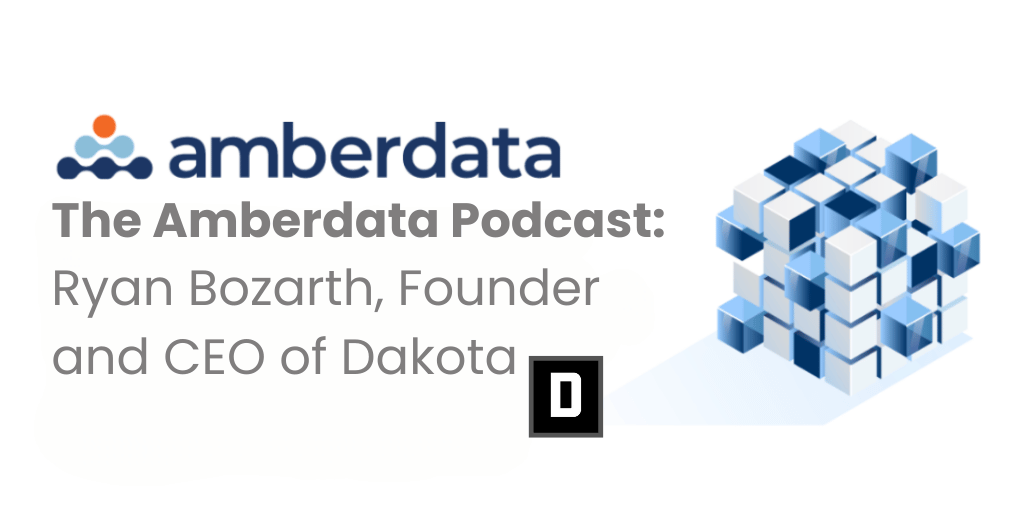Amberdata Podcast Featuring Ryan Bozarth, Founder and CEO of Dakota

Welcome to Amberdata's Podcast series featuring leaders in the digital asset space where we explore the intersection of finance, blockchain, and technology! In this episode, Chris Martin, Director of Research at Amberdata interviews Ryan Bozarth, Founder and CEO of Dakota!
Summary
In this podcast, Amberdata Director of Research Chris Martin interviews the founder and CEO of Dakota Ryan Bozarth. Before founding Dakota, Ryan was the CEO of Coinbase Custody and Head of Product at Anchorage. In this interview, we discuss the enterprise use cases of stablecoins and the future for these real world assets and get an inside look into Dakota – a modern, crypto-native bank for businesses.
Background and Introduction to Crypto
Ryan Bozarth has spent the last six years deeply embedded in the world of cryptocurrency, particularly in building large crypto custodians. He was previously the CEO of Coinbase Custody and the first Head of Product at Anchorage. His career before crypto was in traditional tech, where he led product and design teams at prominent companies like Square, Airbnb, and Sony.
Ryan’s entry into the crypto world began during his time at Airbnb, where he participated in a group called "Block BNB," which focused on discussions around blockchain technology and cryptocurrency. His interest grew from these early experiences, leading him to work full-time in the crypto space, particularly at Anchorage.
Observations on the Crypto Industry
Chris and Ryan dive into the current state of the cryptocurrency market, focusing on stablecoins and real-world assets (RWAs). Stablecoins, which have become a cornerstone of decentralized finance (DeFi), have experienced significant growth, moving from a market cap of single-digit billions a few years ago to over $150 billion today. Ryan projects that within the next five years, the stablecoin market could exceed a trillion dollars.
However, with this growth comes volatility and the challenge of navigating regulatory landscapes. Ryan points out that while stablecoins have proven their utility, especially in DeFi, the regulatory environment remains turbulent. The introduction of frameworks like the Markets in Crypto-Assets (MiCA) regulation in Europe, which aims to provide a structured regulatory environment for crypto, could either stabilize or further disrupt the market, depending on how these regulations are implemented.
Ryan emphasizes that the future of stablecoins will likely see the emergence of more specialized products. While traditional fiat-backed stablecoins like USDC and USDT dominate the market, there is growing interest in yield-generating stablecoins. Companies such as Aura, Mountain, and even PayPal are exploring ways to offer yield on stablecoins as a means of gaining market share.
He also draws parallels between yield-bearing stablecoins and liquid staking derivatives, noting that both have the potential to attract more risk-tolerant investors. However, Ryan believes the more significant growth opportunity lies in traditional financial services, where stablecoins can reduce costs and improve efficiencies, particularly for neobanks and fintech companies.
The Role of Real-World Assets and Institutional Involvement
When discussing the future of real-world assets on the blockchain, Ryan highlights the potential for institutions to drive significant growth. He sees a future where blockchain technology enables global access to assets like U.S. Treasuries and corporate bonds, particularly for investors outside the U.S. who currently face barriers to entry.
Ryan also notes that institutional involvement, exemplified by companies like BlackRock, could bring more stability to the crypto markets over time. As more traditional financial institutions adopt crypto, the increased liquidity and infrastructure will likely smooth out the volatility that has characterized the market so far.
Introduction to Dakota
The conversation then shifts to Ryan's new venture, Dakota, which he describes as a blend of a modern banking app and a crypto-native platform. Dakota aims to bridge the gap between traditional financial services and the emerging world of decentralized finance.
Dakota’s primary customers are crypto companies, ranging from large foundations to early-stage startups, as well as traditional startups that face challenges in accessing financial services. Ryan explains that Dakota is built differently from traditional banks, which typically operate as software layers on top of regional banks. Instead, Dakota is built on stablecoin infrastructure, allowing customers to hold stablecoins that are backed by U.S. Treasuries and move money globally with greater speed and efficiency.
This model offers customers the benefits of both traditional banking and crypto-native solutions. Customers can choose to hold their assets in stablecoins or U.S. dollars and can make payments in either currency. Dakota also provides access to yield from U.S. Treasuries, offering a compelling value proposition for businesses looking to optimize their treasury management.
Risk Management and Regulatory Considerations
A key feature of Dakota is its approach to risk management. Unlike traditional banks, where customer deposits are liabilities on the bank’s balance sheet, Dakota customers retain ownership of their assets, which are not lent out. This model reduces the need for traditional FDIC insurance, though Dakota is developing a policy similar to FDIC insurance to protect against the risk of stablecoin de-pegging.
Ryan acknowledges the challenges posed by the current regulatory environment in the U.S., particularly the increased scrutiny of crypto-friendly banks. However, he believes that as the industry matures and more institutions come on board, the regulatory landscape will eventually stabilize, allowing for continued growth and innovation.
Conclusion
Ryan Bozarth’s vision for Dakota represents a significant step forward in integrating traditional financial services with the advantages of blockchain technology. By providing businesses with a platform that offers both stability and access to the benefits of decentralized finance, Dakota is well-positioned to be a key player in the future of financial services. As the regulatory environment evolves and more institutions adopt blockchain technology, Ryan believes that Dakota will play a crucial role in shaping the next phase of the crypto industry.
Amberdata
Amberdata is the leading provider of global financial infrastructure for digital assets. Our institutional-grade solutions deliver data, analytics and comprehensive tools and insights that empower financial institutions to research, trade, and manage risk and compliance in digital assets. Amberdata serves as a...
